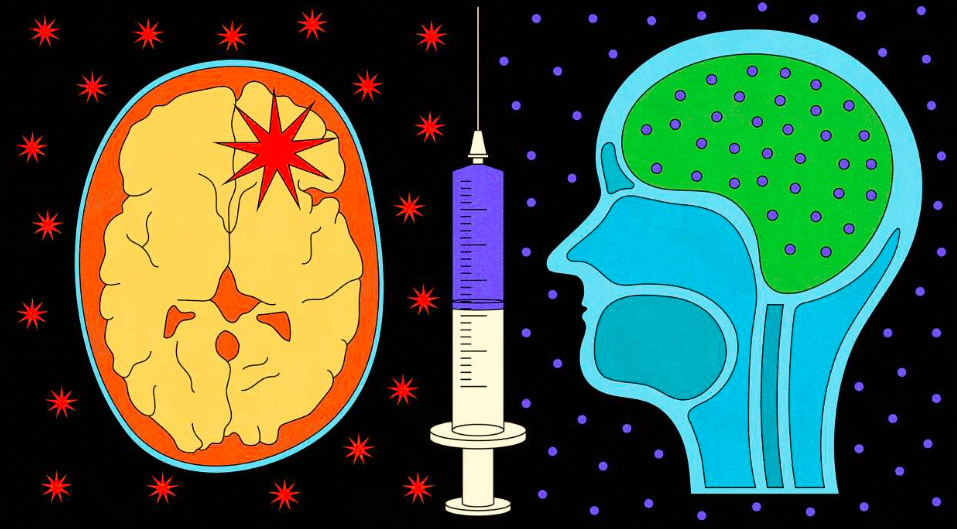Trending Stories
SurVaxM: A Beacon of Hope in the Battle Against Deadly Brain Cancer, Glioblastoma

SurVaxM: A Beacon of Hope in the Battle Against Deadly Brain Cancer, Glioblastoma
Harnessing the Power of the Immune System against Glioblastoma
A ground-breaking experimental vaccine, SurVaxM, is ushering in new hope in the fight against glioblastoma, a relentless and deadly form of brain cancer.
The vaccine aims at delaying the tumor’s recurrence by targeting a protein found in these tumors called survivin, believed to foster cancer cell survival. If survivin is obliterated, the presumption is that the cancer cells will also be eradicated.
Glioblastoma represented nearly half of all malignant brain tumors diagnosed in the U.S. last year, with more than 14,000 cases reported, according to spokesperson, Tom Halkin. With a heartrending five-year survival rate of just 6.8%, this disease leaves patients and their families in devastation.
SurVaxM: Turning the Tide in Glioblastoma Treatment
John Wishman: A Story of Resilience and Hope
John Wishman, a 61-year-old resident of Buffalo, New York, was diagnosed with glioblastoma in the fall of 2020. Defying the odds of a disease with an average survival time of 12 to 18 months, Wishman is still living an active life two and a half years later, thanks to SurVaxM. Wishman’s story brings hope to many other patients and families grappling with this ferocious disease.
From Clinical Trials to Reality: The Journey of SurVaxM
An early-stage clinical trial reported that SurVaxM extended the average survival time for glioblastoma patients to 26 months. Now, the manufacturer, MimiVax, based in New York, is in the process of enrolling patients for a larger trial to corroborate these initial findings.
The planned trial, anticipated to involve more than 10 sites across the U.S. and China, will engage up to 270 patients. This comprehensive study will compare the outcomes of patients receiving the SurVaxM vaccine to those receiving standard care.
The Challenge of Glioblastoma: A ‘Tentacled’ Adversary
Glioblastoma is a notably aggressive cancer. By the time of diagnosis, it typically has already spread to other parts of the brain and spinal cord. Owing to its invasive nature, the complete surgical removal of the tumor is usually unachievable.
This form of brain cancer can be likened to the tentacles of an octopus, stretching into different parts of the brain, explains Honggang Cui, an associate professor at Johns Hopkins Whiting School of Engineering.
Although treatments involving surgery, chemotherapy, and radiation are standard, recurrence is common if even a single cancer cell remains.
The Mechanism of SurVaxM: An Immune System ‘Training’
SurVaxM’s approach is quite innovative; it “trains” the immune system to recognize and attack cancer cells. If the cells do make a comeback, the body is prepared to eliminate them, thus preventing a new tumor from forming, according to Michael Ciesielski, the CEO of MimiVax.
Navigating the Future of Glioblastoma Treatment with SurVaxM
Despite the promise of SurVaxM, results from the Phase 2b trial are not expected until mid-2024. If the trial proves successful, a larger Phase 3 clinical trial will be required. However, the high mortality rates associated with gi
The high mortality rates associated with glioblastoma justify the need for the relentless pursuit of new treatments and the exploration of immunotherapy’s full potential, states Dr. Alyx Porter, a neuro-oncologist at the Mayo Clinic in Phoenix, who isn’t part of the SurVaxM trial.
Initial results indicate that SurVaxM is safe, with reported side effects including fever, itching, redness, and muscle aches, according to Dr. Robert Fenstermaker, the chair of the neurosurgery department at the Roswell Park Comprehensive Cancer Center and co-creator of SurVaxM.
Meanwhile, MimiVax is also exploring the potential of SurVaxM for treating other forms of cancer, including multiple myeloma and neuroendocrine tumors, a rare type of cancer found in various organs, including the lungs, pancreas, and gastrointestinal tract.
Conclusion
As we advance further into the era of precision medicine and personalized treatments, SurVaxM could prove to be a significant milestone in the fight against glioblastoma and possibly other cancers.
Despite the road ahead is fraught with challenges and uncertainties, the relentless pursuit of innovation brings us a glimmer of hope, signaling a potential turning point in cancer therapy.
References:
Trending Stories
Sister Regina Liu: Empowering Health Through Acupuncture

Sister Regina Liu: Empowering Health Through Acupuncture
In the bustling world of healthcare, Sister Regina Liu stands out as a beacon of holistic healing. Her journey into the world of acupuncture is not only inspiring but also transformative for the countless individuals she has treated.
Through her dedication, Sister Regina has brought traditional Chinese medicine to the forefront, offering an alternative and complementary approach to modern medical practices.
The Journey of Sister Regina Liu
Sister Regina Liu’s path to becoming a renowned acupuncturist began with her deep-rooted interest in holistic health. Born into a family that valued traditional Chinese medicine, Sister Regina was exposed to the benefits of acupuncture from a young age. Her early fascination turned into a lifelong passion as she pursued formal education and training in the field.
Acupuncture: Bridging Ancient Wisdom and Modern Health
Acupuncture, a practice with origins in ancient China, involves inserting thin needles into specific points on the body to balance the flow of energy or “qi.” Sister Regina Liu has mastered this ancient art, using it to address a wide range of health issues.
From chronic pain to stress management, her expertise has provided relief to many who had exhausted conventional treatment options.
Impact on Community Health
Sister Regina’s impact extends beyond individual treatments. She has been instrumental in educating the community about the benefits of acupuncture, breaking down misconceptions, and making the practice more accessible.
Her workshops and seminars have enlightened many about the holistic approach to health, emphasizing the interconnectedness of body, mind, and spirit.
Success Stories and Testimonials
The success stories of Sister Regina’s patients are a testament to her skill and dedication. Many individuals who had lost hope found solace in her treatments.
For instance, Maria, a long-time sufferer of migraines, experienced significant relief after just a few sessions with Sister Regina. Her story is just one of many that highlight the transformative power of acupuncture under Sister Regina’s care.
Challenges and Triumphs
Like any journey, Sister Regina’s path was not without challenges. Integrating acupuncture into mainstream healthcare faced resistance initially.
However, her perseverance and the undeniable results of her treatments gradually won over skeptics. Today, Sister Regina is not only respected in the field of acupuncture but also in the broader medical community.
The Science Behind Acupuncture
While acupuncture is rooted in ancient practices, modern science has begun to unravel the mechanisms behind its effectiveness. Studies have shown that acupuncture can stimulate the release of endorphins, the body’s natural painkillers, and improve blood circulation.
These scientific validations have further cemented acupuncture’s place in contemporary healthcare, thanks in part to advocates like Sister Regina Liu.
Acupuncture in Modern Healthcare
Sister Regina’s work exemplifies how traditional practices can complement modern medicine. Hospitals and clinics increasingly incorporate acupuncture into their treatment plans, recognizing its benefits in pain management, mental health, and overall well-being. This integration signifies a broader acceptance and understanding of holistic health practices.
Future Vision
Looking ahead, Sister Regina Liu envisions a future where acupuncture and traditional Chinese medicine are fully integrated into the global healthcare system. She continues to advocate for research, education, and policy changes that support the inclusion of holistic practices in mainstream medicine.
How to Get Started with Acupuncture
For those new to acupuncture, Sister Regina offers practical advice on getting started. She recommends finding a certified acupuncturist, understanding the treatment process, and maintaining an open mind. Her guidance helps demystify acupuncture, making it more approachable for newcomers.
Conclusion
Sister Regina Liu’s journey in empowering health through acupuncture is a remarkable tale of dedication, resilience, and success. Her contributions have not only alleviated individual suffering but also enriched the broader understanding of holistic health. As acupuncture continues to gain recognition, Sister Regina’s legacy will undoubtedly inspire future generations of healers.
FAQs
1. What conditions can acupuncture treat?
Acupuncture can address various conditions, including chronic pain, migraines, stress, anxiety, digestive issues, and more. It is also used to support overall wellness and balance.
2. Is acupuncture safe?
Yes, when performed by a certified and experienced acupuncturist, acupuncture is safe. It involves using sterile, single-use needles and adhering to proper hygiene practices.
3. How many sessions are needed to see results?
The number of sessions varies depending on the condition and individual response. Some may experience relief after one session, while others may need multiple treatments.
4. Does acupuncture hurt?
Acupuncture needles are very thin, and most people feel minimal to no discomfort. Some may feel a slight tingling or warmth at the needle site.
5. How do I find a qualified acupuncturist?
Look for acupuncturists who are certified by recognized professional organizations and have positive patient reviews. Personal recommendations and consultations can also help in making an informed choice.
References
Trending Stories
In 2 Shape Gym Unveils Major Expansion in Stourport
Trending Stories
9 Reasons Why In-Person Friendships Are Irreplaceable
-

 Trending Stories1 year ago
Trending Stories1 year agoCDC: 1 in 4 Americans Still COVID-Free by End of 2022
-

 Health5 years ago
Health5 years agoMeghan Trainor Shares Motivational New Song ‘Blink’
-

 Health2 years ago
Health2 years agoHow Long Does Monkey Pox Last Before It Surfaces in the Body?
-

 Health2 years ago
Health2 years agoWhat Causes Swollen Body? Understanding Edema and its Triggers
-

 Health3 years ago
Health3 years agoNutrition and the Importance of a Fitness Program – 3 Things to Know
-

 Health3 years ago
Health3 years ago5 Weird Reasons Why Pimples Disappear After Marriage
-

 Health3 months ago
Health3 months agoHow Do Pawpaw Seeds Support Cardiovascular Health?
-

 Health2 years ago
Health2 years agoHealth Benefits Of Pawpaw Seed? 7 Things To Know







